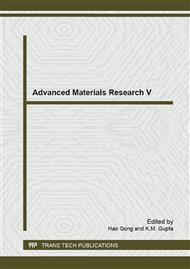p.264
p.269
p.274
p.280
p.285
p.293
p.299
p.305
p.311
Molecular Dynamics Simulation of the Thermal Conductivity of Silicon-Germanene Nanoribbon (SiGeNR): A Comparison with Silicene Nanoribbon (SiNR) and Germanene Nanoribbon (GeNR)
Abstract:
This study examines the nature of thermal transport properties of single layer two-dimensional honeycomb structures of silicon-germanene nanoribbon (SiGeNR), silicene nanoribbon (SiNR) and germanene nanoribbon (GeNR) which have not yet been characterized experimentally. SiGeNR, SiNR and GeNR are the allotropes of silicon-germanium, silicon and germanium, respectively, with sp2 hybridization. The thermal conductivity of the materials has been investigated using Tersoff potential through LAMMPS (Large-scale Atomic/Molecular Massively Parallel Simulator) by performing the molecular-dynamics simulations. The temperature is varied (50 K, 77 K, 150 K, 300 K, 500 K, 700 K, 1000 K, and 1200 K) with fixed nanoribbon dimension of 50 nm × 10 nm. The length is also varied (10 nm, 20 nm, 30 nm, 40 nm, and 50 nm) while the temperature is fixed at room temperature and the width is also fixed at 10 nm. The obtained results showed that the thermal conductivity of SiGeNR at room temperature is approximately 10 times higher than GeNR and approximately 6 times higher compared to SiNR. The thermal conductivity increases as the temperature is increased from 50 K – 300 K, and as the temperature is further increased, the thermal conductivity decreases with temperature. Moreover, the thermal conductivity in SiGeNR, SiNR, and GeNR increases as the length is being increased. Predicting new features of SiGeNR, SiNR and GeNR open new possibilities for nanoelectronic device applications of group IV two-dimensional materials.
Info:
Periodical:
Pages:
285-289
Citation:
Online since:
May 2015
Keywords:
Price:
Сopyright:
© 2015 Trans Tech Publications Ltd. All Rights Reserved
Share:
Citation:


